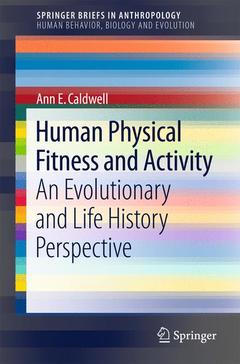?The science of human physical activity and fitness is ripe for a novel theoretical framework that can integrate the ecological, genetic, physiological and psychological factors that influence physical activity in humans. Physical inactivity dominates most developed nations around the world, and is among the leading causes of disease burden and death worldwide. Despite the wide array of physical and mental health benefits, few people get the recommended level of physical activity to achieve these benefits. Current research on physical activity has not, as of yet, been successful for the development of effective exercise interventions. Several researchers have advocated a more integrative approach that takes evolutionary history into account, but such a framework has yet to be advanced. To that aim, the first goal of this book is to present a comprehensive evolutionary and life history framework that highlights the domain-specific aspects of the evolved psychology and physiology that can lead to a more integrated and complete understanding of physical activity across the lifespan. It summarizes and extends previous work that has been done to understand the ways natural selection has shaped physical activity in humans in traditional and modern economies and environments. In many ways, humans are adapted to be physically active. Overall, however, natural selection has shaped a flexible, but energy conscious system that responds to environmental and individual costs and benefits of physical activity to optimally allocate a finite energetic budget across the lifespan. This system is adapted to respond to cues of resource scarcity and high levels of obligatory physical activity, and conserves energy to favor allocation in ways that increase the likelihood of reproductive success and survival. This nuanced application leads to a more thorough understanding of the circumstances that natural selection is predicted to favor both sedentary and active behaviors in predictable ways across the lifespan. The second goal of this book is to synthesize and interpret cross-disciplinary research (from biological and evolutionary anthropology and psychology; epidemiology; health psychology; and exercise physiology) that can illuminate original approaches to increase physical activity in modern, primarily sedentary contexts. This includes a breakdown of the human lifespan to discuss the predicted costs and benefits of physical activity at each stage of life in order to differentiate the obstacles to physical activity and exercise that are functionally adaptive?or were in the environments that they evolved?and identifying which factors are more modifiable than others in order to develop interventions and environments that are more conducive to physical activity. Normal 0 false false false EN-US JA X-NONE /* Style Definitions */ table.MsoNormalTable {mso-style-name:"Table Normal"; mso-tstyle-rowband-size:0; mso-tstyle-colband-size:0; mso-style-noshow:yes; mso-style-priority:99; mso-style-parent:""; mso-padding-alt:0in 5.4pt 0in 5.4pt; mso-para-margin-top:0in; mso-para-margin-right:0in; mso-para-margin-bottom:10.0pt; mso-para-margin-left:0in; line-height:115%; mso-pagination:widow-orphan; font-size:11.0pt; font-family:"Calibri","sans-serif"; mso-ascii-font-family:Calibri; mso-ascii-theme-font:minor-latin; mso-hansi-font-family:Calibri; mso-hansi-theme-font:minor-latin; mso-bidi-font-family:"Times New Roman"; mso-bidi-theme-font:minor-bidi;}

